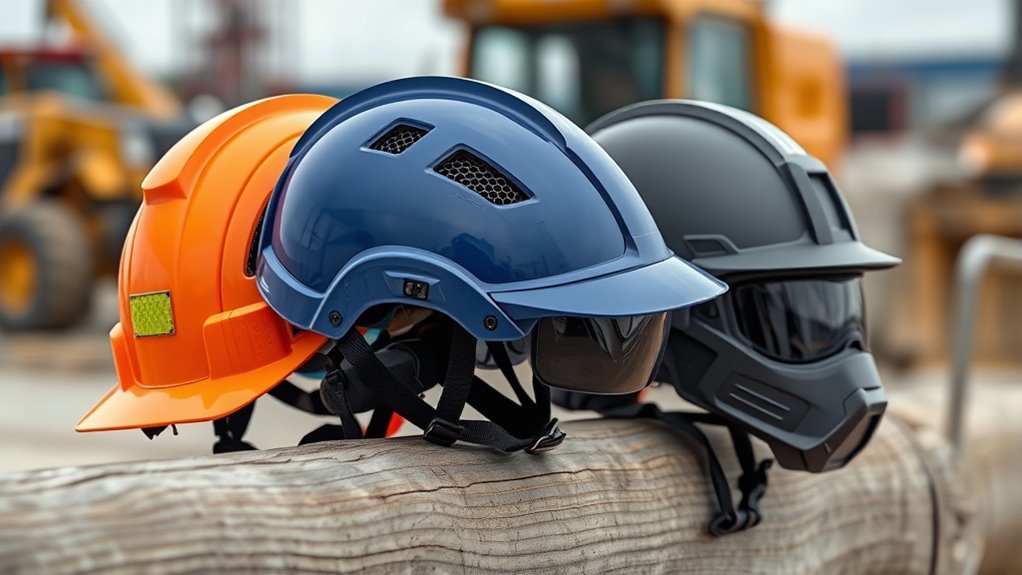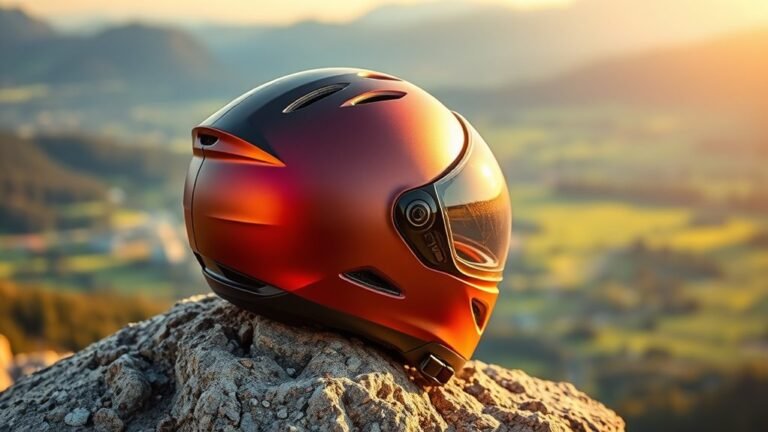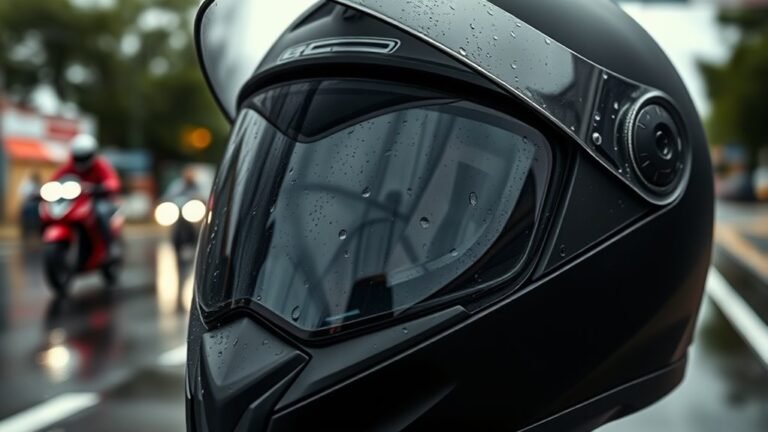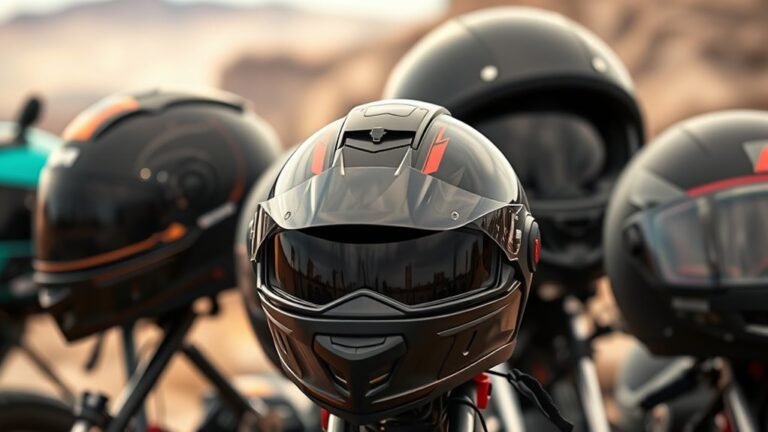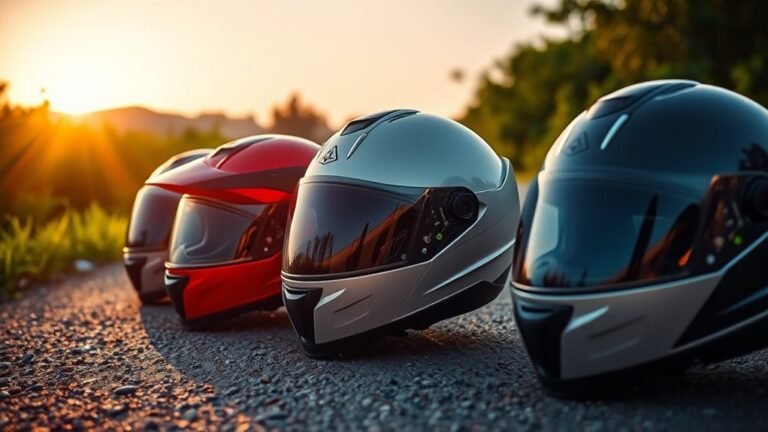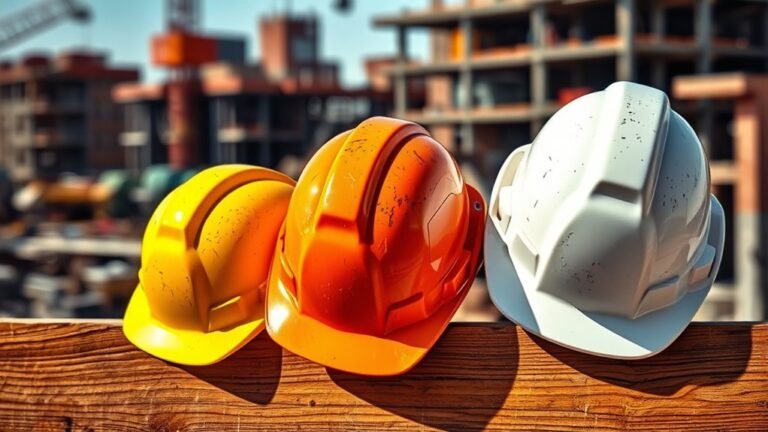Best Construction Helmets for Extreme Conditions
When choosing a construction helmet for extreme conditions, focus on safety, comfort, and fit. Look for heat-resistant materials for high temperatures or thermal liners for cold weather. Adjustable suspension systems and moisture-wicking liners enhance comfort and airflow. Verify your helmet is certified by ANSI or CSA for peak impact resistance. Lightweight designs reduce fatigue during long hours on-site. For more details on specific helmet recommendations, features, and maintenance strategies, further information is available.
Importance of Choosing the Right Helmet for Extreme Conditions
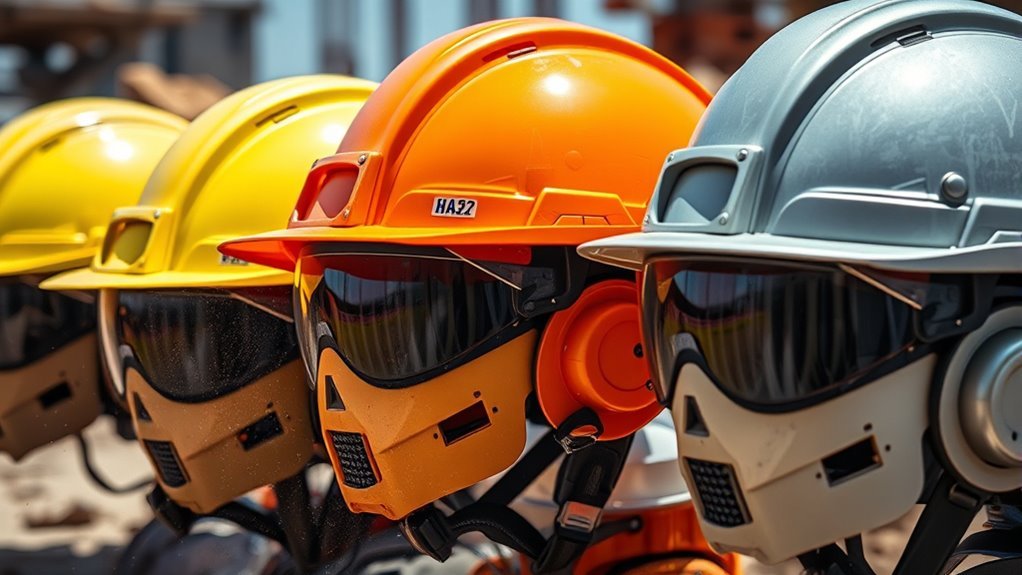
When working in extreme conditions, choosing the right helmet isn’t just a matter of comfort; it’s essential for your safety. A properly fitted helmet greatly enhances helmet safety by minimizing the risk of head injuries from falling objects or accidental impacts. It’s important to assess the specific hazards you’ll face in your work environment, as different conditions require different levels of protection. Additionally, worker comfort plays a significant role; an uncomfortable helmet can distract you and reduce your efficiency. Opting for a lightweight design with ventilation can help maintain focus while ensuring protection. Remember, your freedom to work effectively hinges on having the right helmet that balances both safety and comfort in challenging situations. Make your choice wisely.
Features to Look for in a Construction Helmet
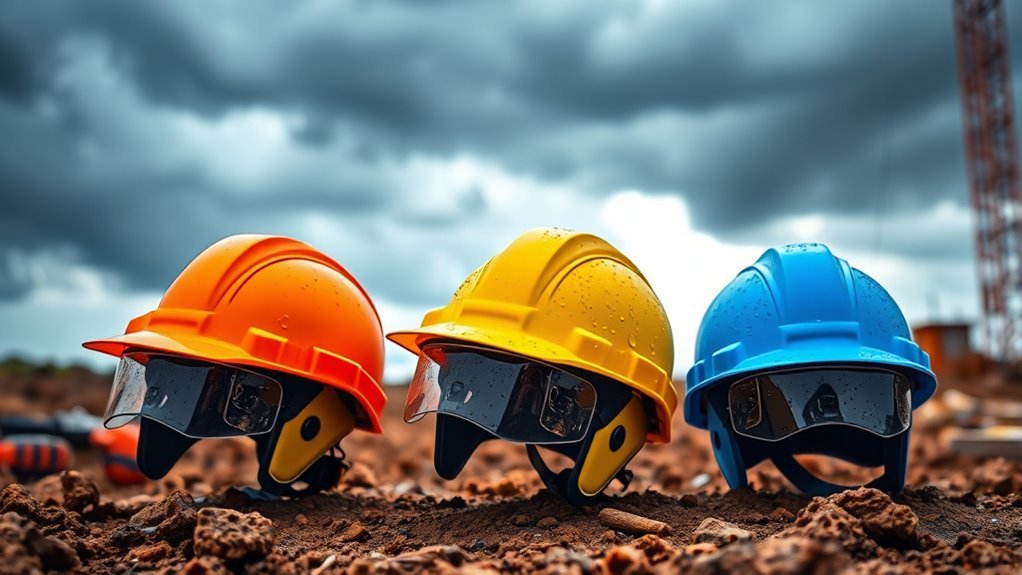
Choosing the right construction helmet involves understanding key features that enhance both safety and comfort. First, consider the construction helmet types available, such as hard hats, bump caps, and full-brim helmets, each serving specific needs. Look for features like adjustable suspension systems that provide a snug fit and comfort padding to reduce fatigue during long hours. Ventilation is also vital, especially in extreme conditions, to promote airflow. Verify the helmet meets safety certification requirements, such as ANSI or CSA standards, guaranteeing it withstands impacts and penetration hazards. Finally, don’t overlook additional features like integrated face shields or hearing protection, which can provide extra safety and versatility in various environments.
Top Construction Helmets for High Temperatures
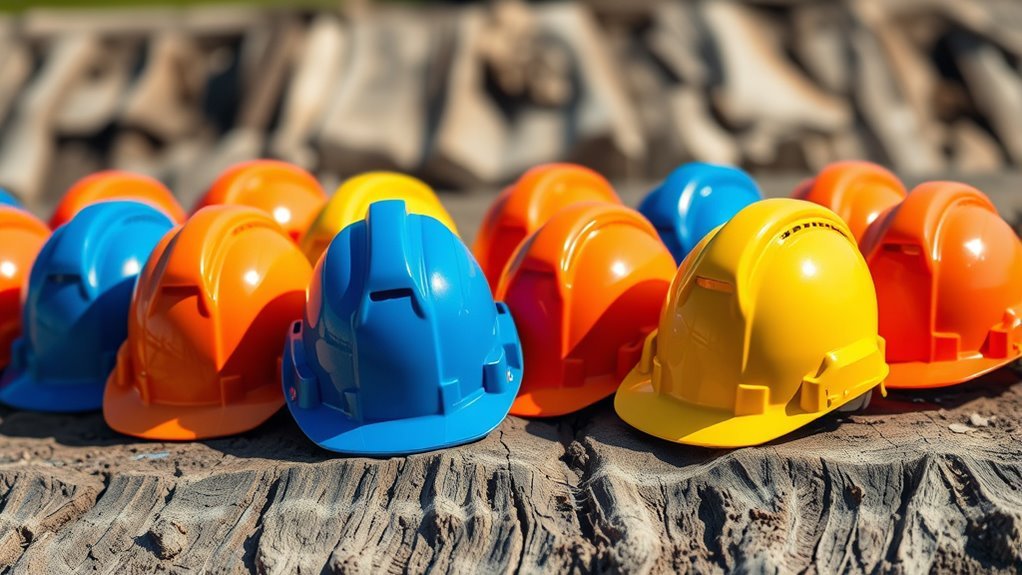
When working in high-temperature environments, selecting a construction helmet made from heat-resistant materials is essential for your safety. Additionally, helmets with effective ventilation features can help regulate temperature and enhance comfort during long hours on the job. Understanding these aspects will guarantee you choose the right helmet for extreme conditions.
Heat-Resistant Materials
As high temperatures are common in many construction environments, selecting a helmet made from heat-resistant materials is essential for ensuring safety and comfort. Look for helmets constructed from high-density polyethylene (HDPE) or polycarbonate, both known for their excellent heat resistance and material durability. These materials can withstand extreme temperatures without compromising structural integrity. Additionally, helmets featuring a thermoplastic shell provide enhanced protection against heat-related hazards. It’s important to choose a design that meets safety standards while also offering lightweight options, ensuring you can work effectively without feeling weighed down. Remember, investing in a quality heat-resistant helmet not only protects you from thermal risks but also promotes long-term comfort on the job site.
Ventilation Features
Effective ventilation features are essential for construction helmets used in high-temperature environments, since they help regulate airflow and reduce heat buildup. Look for helmets that incorporate breathable materials, which enhance comfort by allowing moisture to escape while promoting cooling. Adjustable vents are another important aspect; they provide flexibility, enabling you to tailor airflow according to the conditions you’re facing. Some helmets offer sliding or rotating vents, allowing you to control the amount of air entering, so you can stay focused on your work without discomfort. Investing in a helmet with these ventilation features not only boosts your comfort but also enhances your productivity in extreme heat, ensuring you maintain the freedom to work effectively and safely.
Best Helmets for Cold Weather Environments
When working in cold weather environments, it’s vital to choose helmets that provide effective insulation and warmth features to keep you comfortable. Additionally, proper ventilation is important to prevent moisture buildup while maintaining warmth. Finally, make sure that your helmet meets impact resistance standards to protect you from potential hazards in these challenging conditions.
Insulation and Warmth Features
While working in frigid conditions, having a construction helmet that offers insulation and warmth features is essential for maintaining safety and comfort. These helmets should incorporate high-quality insulation materials to enhance warmth retention, ensuring you stay focused on the task at hand without the distraction of cold.
Look for helmets that include:
- Thermal liners for added insulation
- Earmuffs to protect your ears from cold winds
- Chin straps to secure the helmet in place during gusts
- Moisture-wicking liners to keep sweat away while maintaining warmth
Selecting a helmet with these features will help you thrive in extreme cold, allowing you to work freely and confidently while staying protected from the elements.
Ventilation for Cold Weather
Although staying warm is essential in cold weather, proper ventilation in construction helmets is equally important to guarantee comfort and safety. Efficient ventilation systems prevent moisture buildup and reduce heat stress, ensuring you stay comfortable while working in harsh conditions. Look for helmets designed with adjustable vents that allow airflow without compromising insulation.
| Helmet Model | Ventilation System | Cold Weather Rating |
|---|---|---|
| Model A | Passive Ventilation | Excellent |
| Model B | Adjustable Vents | Very Good |
| Model C | Active Ventilation | Good |
| Model D | Fixed Vents | Fair |
Choosing the right helmet with effective ventilation systems is vital in cold weather for maintaining productivity and focus on the job.
Impact Resistance Standards
As you navigate cold weather environments on construction sites, understanding impact resistance standards is essential for guaranteeing your safety. Helmets must undergo rigorous impact testing to meet safety regulations, providing reliable protection against falling objects and other hazards.
When selecting the best helmets, consider the following criteria:
- Material durability: Confirm the helmet is made from high-quality, impact-resistant materials.
- Temperature performance: Look for models designed to maintain their structural integrity in extreme cold.
- Certification compliance: Verify that the helmet meets recognized safety standards (ANSI, CSA).
- Fit and comfort: A proper fit enhances both safety and comfort, allowing you to focus on your tasks.
Impact-Resistant Helmets for Hazardous Worksites
When working on hazardous worksites, it’s vital to prioritize safety, and impact-resistant helmets serve as a key line of defense. These helmets are designed to withstand considerable force, protecting your head from falling objects and other potential hazards. Look for models that comply with industry safety certifications, which guarantee they meet rigorous impact resistance standards. Helmets with high impact resistance not only absorb shocks but also minimize injury risk during unexpected incidents. It’s important to choose a helmet that fits properly, as a secure fit maximizes protection. Remember, investing in a quality impact-resistant helmet can greatly enhance your safety while allowing you the freedom to focus on your tasks without constant worry about head injuries.
Helmets With Enhanced Ventilation Systems
Impact-resistant helmets offer significant protection, but they can sometimes trap heat and moisture, leading to discomfort during long hours on the job. That’s where helmets with enhanced ventilation systems come into play. These helmets utilize advanced ventilation technology and innovative airflow design to guarantee you stay cool and comfortable while working.
Key features include:
- Strategic vents that promote ideal airflow.
- Moisture-wicking liners that help manage sweat.
- Adjustable airflow controls for personalized comfort.
- Lightweight materials that don’t compromise safety.
Lightweight Options for Extended Wear
How can you guarantee comfort without sacrificing safety during long hours on a construction site? Opting for helmets made from lightweight materials is essential. These helmets not only reduce fatigue but also provide the necessary protection against potential hazards. Look for models that feature an ergonomic design, which conforms to the shape of your head and distributes weight evenly. This design minimizes pressure points, allowing for extended wear without discomfort. Many lightweight helmets also include additional features like moisture-wicking liners and adjustable straps, enhancing overall comfort. By choosing a helmet that combines safety with these advanced materials and designs, you can focus on your work without the distraction of discomfort, ensuring you stay both safe and productive on the job.
Maintenance and Care for Your Construction Helmet
Maintaining the integrity and functionality of your construction helmet is essential for guaranteeing its protective capabilities over time. Regular care not only enhances helmet longevity but also guarantees your safety on-site. Here are some effective cleaning techniques you should adopt:
- Wipe down the exterior with a damp cloth to remove dirt and debris.
- Inspect the suspension system frequently for wear and tear; replace if needed.
- Avoid harsh chemicals that can degrade materials; use mild soap instead.
- Store your helmet in a cool, dry place away from direct sunlight to prevent deterioration.
Regulatory Standards and Certifications to Consider
When selecting a construction helmet, it’s crucial to understand the regulatory standards and certifications that guarantee your helmet meets safety requirements. Look for compliance with OSHA (Occupational Safety and Health Administration) safety regulations, which confirm that helmets provide adequate protection against impact and penetration. Additionally, check for ANSI (American National Standards Institute) certification requirements, specifically the Z89.1 standard, which outlines performance criteria. Helmets meeting these standards undergo rigorous testing for durability and effectiveness in extreme conditions. You might also encounter other certifications, like CSA (Canadian Standards Association), depending on your location. By prioritizing these certifications, you provide the freedom to work confidently in hazardous environments, knowing your helmet offers maximum protection.
Frequently Asked Questions
Can Construction Helmets Be Customized With Company Logos or Colors?
Yes, construction helmets can be customized with company logos and colors. Many manufacturers offer helmet branding options that allow you to add your logo directly onto the helmet surface. Additionally, helmet color customization is often available, enabling you to choose specific shades that align with your brand identity. This level of personalization not only enhances visibility on-site but also reinforces team unity and brand recognition, giving you the freedom to express your company’s identity.
How Often Should I Replace My Construction Helmet?
Think of your construction helmet as a trusty shield in a battlefield; its effectiveness diminishes over time. You should replace your helmet every 3 to 5 years, even if it appears intact. Frequent inspections and helmet maintenance are essential, as cracks and wear can compromise safety. If you notice any signs of damage or after a significant impact, it’s time for a replacement. Staying proactive guarantees you’re always protected, allowing you to focus on the task at hand.
Are There Specific Helmets for Women in Construction?
Yes, there are specific helmets designed for women in construction. These women’s helmet features often include a better fit, adjustable straps, and enhanced comfort for longer wear. It’s essential that any helmet you choose complies with safety standards to guarantee maximum protection on the job site. Selecting a helmet tailored for women not only improves comfort but also boosts confidence, allowing you to focus on your work while knowing you’re safe.
What Is the Average Lifespan of a Construction Helmet?
The average lifespan of a construction helmet is typically around 3 to 5 years, but this can vary based on several helmet lifespan factors. Environmental conditions, frequency of use, and impact exposure all play a role. To maximize longevity, you should follow maintenance tips like inspecting for cracks, cleaning regularly, and storing it properly away from direct sunlight. Remember, replacing a helmet sooner rather than later can guarantee peak protection on the job.
Can I Wear a Beanie or Cap Under My Helmet?
Yes, you can wear a beanie or cap under your helmet, but it’s vital to guarantee it doesn’t compromise safety. Studies show that nearly 70% of workers prioritize helmet comfort, especially in extreme temperatures. A beanie can aid in temperature regulation, keeping you warm in cold conditions. However, always check that the added layer doesn’t interfere with the helmet’s fit or functionality, as a secure fit is necessary for protection.
